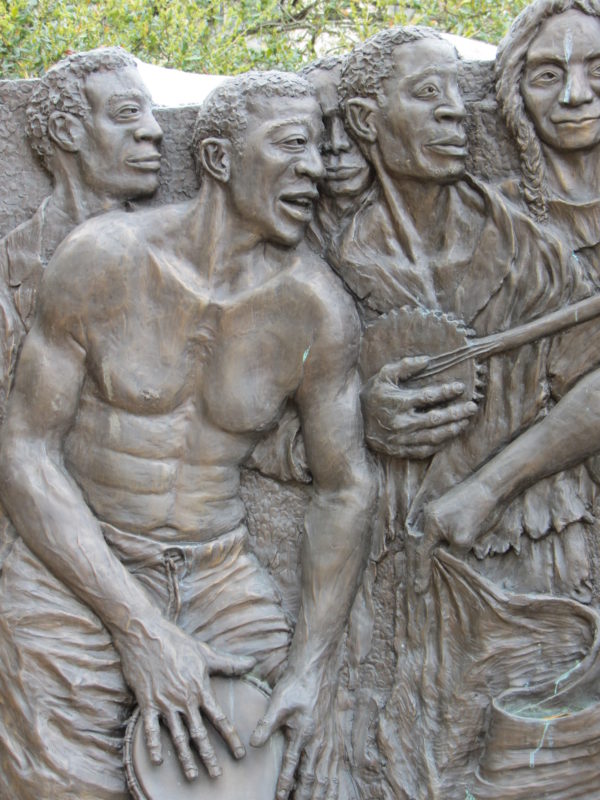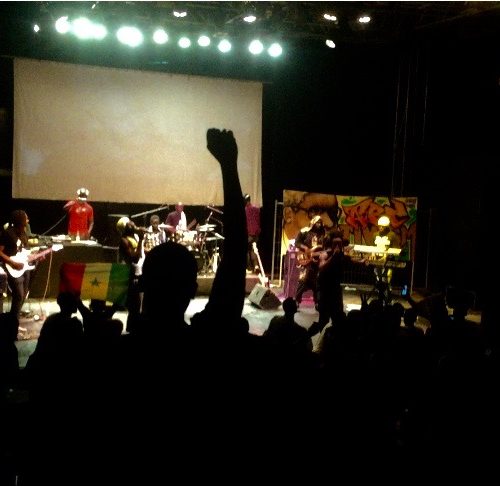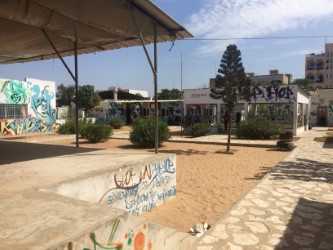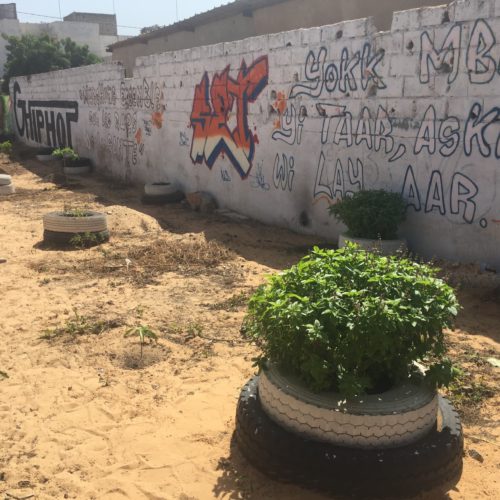Editor’s Note: The following series “Boots n’ Blues” is a week-long series curated by Kila Moore as part of the Digital Research Internship Program in partnership with ViaNolaVie. The DRI Program is a Newcomb Insitute technology initiative for undergraduate students combining technology skill sets, feminist leadership, and the digital humanities.
In the toe of Louisiana lies one of the world’s greatest contributions to music: the city of New Orleans. The trumpets and trombones heard from the city’s infamous second-lines have inspired so much of the music we hear today — from jazz (New Orleans’ specialty), to blues, bounce, and hip-hop — its legacy on the sound of America’s music is unprecedented. This collection of articles explores the presence and impact of New Orleans’ music scene from the red lights of Storyville to the neon lights of Bourbon Street. And while the streets are silent from the effects of COVID-19, it is the perfect time to remember why music is so important to so many.
“Baby go ‘head, baby go ‘head” signals a party is about to start in New Orleans — but the love of bounce music has been reaching from border to border. Originally published on July 11, 2017, Emily Grimes writes about the love of hip hop on a nationwide level.
According to Holly Hobbs, a researcher working on the NOLA Hip-Hop and Bounce Archive, “there’s no difference between a rapper, a jazz musician, or a rhythm and blues artist from the 1950s. It is all a logical continuum in the trajectory of New Orleans music.” New Orleans is usually associated with jazz music, but hip-hop in the Crescent City also offers a unique perspective into the African roots of New Orleans culture and history.
The city of New Orleans and the West African country of Senegal have been connected since the 18th century, when thousands of African captives were transported across the Atlantic Ocean to supply enslaved labor to the city. As victims of colonialism and the transatlantic slave trade, music and art have been a shared form of resistance. It’s thus no surprise that even though New Orleans and Dakar are on opposite sides of the Atlantic, their hip-hop music reveals shared cultural elements and serve similarly as sources of community empowerment and political resistance to oppression.
In New Orleans, roughly two thirds of the slave population came from the African region of Senegambia and by the end of the slave trade to New Orleans in the early 1730s, Africans made up over half of the total population of the city (Caron, 98). The unique nature of the African population in comparison to the white Europeans in Louisiana contributed to “an unusually cohesive and heavily Africanized culture in lower Louisiana: clearly, the most Africanized slave culture in the United States” (Hall, 161).
The Africanized slave culture of New Orleans thrived and contributed to the musical culture of New Orleans through a “localized African American folk musical culture” that “relied on highly diffused and small-scale practices as well as larger and more organized events” (Miller, 21). Congo Square in New Orleans was an important place in the city that allowed for slaves to “sell their own produce, socialize, and engage in a variety of cultural practices, including music and dance” (Miller, 21).

This statue located in Congo Square represents the musical practices and instruments of the African slave population that gathered there. Flickr Creative Commons, Photo by Jason Riedy
Congo Square, among other locations in the city, “served as important venues for the perpetuation and transmission of African-derived cultural values and practices” (Miller, 22).
The legacies of African culture in New Orleans included musical cultures, and many historians connect the birth of hip- hop to the evolution of blues and jazz–both genres’ origins being traced back to New Orleans. In connection to the jazz tradition, “William Jelani Cobb identifies hip-hop as the ‘folklore of the twenty-first century’ wherein MCs’ narratives extend the blues tradition of story-telling such that hip-hop is now ‘so central to the development of the post-civil-rights generation of black people that it’s nearly impossible to separate the music from our politics, economic realities, gains, and collective shortcomings’” (Perry, 674)
Hip-hop did not originate in New Orleans, but rather, it is documented to the South Bronx in the 1970s, just shortly after the civil rights movement ended in 1965. Hip-hop reflected urban identities and cultures, and gave marginalized communities a platform to express themselves and transform their circumstances during a time when “white flight” to the suburbs and government red-lining isolated urban communities in concentrated poverty.
During this tumultuous time in New York City, DJs hosted block parties on the street and played old funk classics to large neighborhood crowds while experimenting with turntables and developed the technique of break beats, which is how the four elements of hip-hop came into being (Hip Hop Magazine, 1986). These four elements are identified as: graffiti, DJing, b-boying (breakdancing), and emceeing. The modern Emcee/MCs, or Masters of Ceremonies, are today’s rappers, using their flow of wordplay and rhymes to express themselves and often to speak for their communities.
While African American communities in cities like New York were being isolated in urban poverty by white flight and government policy, poor and working-class African Americans in New Orleans “were increasingly isolated within low-lying areas made up of reclaimed swampland” in a city that remained racially and socially divided by the effects of segregation (Miller, 19).
Hip-hop’s roots as community advocacy and a form of resistance to oppression are relevant as well in New Orleans. In the city in 2013, the median income for a White household was $60,553, while that of an African-American household was $25, 102. Since 2005, the median income for Whites had increased by $11,291 and the median income for African-Americans had only increased by $1,708, demonstrating the widening inequality. Aside from economic inequality, African-Americans in New Orleans, though 59% of the city’s population, make up 90% of the New Orleans prison population (Urban League LA).
Music as an expressive culture was, and continues to be “a crucial dimension of African Americans’ psychic survival under these conditions” and is what makes hip-hop music a continuum in the trajectory of New Orleans music. The city’s population demographics “ helped to perpetuate a collective musical sensibility as well as a more general sense of cultural autonomy and enjoyment” that allowed for the development of locally relevant and reflective hip-hop music and culture (Miller, 19).
Bounce
While New Orleans is recognized as the home of many mainstream, internationally recognized hip-hop artists like Lil’ Wayne and Juvenile, the specific genre of Bounce music, described as a “stripped-down rap offshoot” that gained popularity “thanks to a danceable beat, [and] lyrics filled with local references…”, is reflective of how the New Orleans urban community uses a form of hip-hop music to express pride in their own culture and community and to advocate for themselves (Aiges).

Big Freedia performing with the Soul Rebels at the Congo Square stage of New Orleans Jazz and Heritage Fest, 2014
Flickr Creative Commons, Photo by kowarski
Lucky Johnson characterizes bounce music as a “cultural thing,” like jazz and blues, “totally a product of New Orleans.” He says, “In the early 1990s, they took the collaboration of different music, because we didn’t have our own mainstream sound in the hip-hop genre. You had gangster rap and you had commercial rap” (Buck, 85).
What makes Bounce music uniquely New Orleans? As said by Lucky Johnson, who grew up around and participated in the New Orleans bounce scene, “it would have to be the diversity, as far as the jazzy sound, the blues. It would have to be the block parties. It would have to be the every-weekend party somewhere, in somebody’s neighborhood or somebody’s park” (Buck, 147). The use of jazzy sound and call-and-response in bounce music represent how it has evolved from the continued culture of musical expression among the African American population in New Orleans.
New Orleans bounce artist, 10th Ward Buck traces the beginnings of Bounce music to the Uptown New Orleans St. Thomas Housing Project, crediting the unique community atmosphere, where there was always some type of block party or DJ set happening outside. A crucial part of bounce music is its strong relevance to a local community. Songs often feature mentions of neighborhoods or public housing projects, and they usually involve “chanting common phrases heard on the street rather than written raps” (Aignes).
Bounce music represents local urban, and often impoverished communities and engages them in musical expression that reflects the culture of New Orleans and directly relates to and includes them in its content.
Learn more about New Orleans bounce with the documentary, “Ya Heard Me”.
After Hurricane Katrina hit New Orleans in August of 2005 and devastated the city, Bounce music was transformed by the post-Katrina climate in a “radical politicization of a previously ludic form of music-making” (Kish, 675-6).
The strong locally relevant nature of bounce music in New Orleans makes it no surprise that the communities where it thrived adapted the genre to reflect their post-Katrina realities and frustrations.
Bounce contributed to the strong response of the hip-hop community in criticism of the neglect and racism that African Americans experienced in the wake of Hurricane Katrina. In the years after Hurricane Katrina, hip-hop became a tool for African Americans to express and establish their identity after being written off and alienated as refugees in the aftermath of one of the most destructive natural disasters in the United States.
Although Hurricane Katrina was treated as an unprecedented disaster in the US, “the experience of massive upheaval and displacement in the face of natural disaster was not new for the African American community” (Kish, 672). Faced with a heavier burden of “environmental and economic risks of natural disaster as underwritten by discriminatory housing, job distribution, and rescue efforts” and “literally called refugees by most politicians and the mass media in the first week after the hurricane, the displaced population was also figuratively construed as outside the norms of middle-class white citizenship, and, a threat to it” (Kish, 672).
Mia X, a New Orleans Bounce artist’s song, “My FEMA People” serves as a good example of how the bounce community used its strong local roots to advocate for marginalized communities and expose the horrors experienced by the African American population post-Katrina. An excerpt from this Seventh Ward artist’s song:
“Ride through my city Beirut. Iraq. Ride through
my city I ride and cry all through the city Looking
for the culture all through the city We were left for
dead for vultures all through the city Its so much
bigger than the weather”
Another New Orleans artist, 5th Ward Weebie, who represents his ward with his name, came out with a song called “F*** Katrina”.
Lil Wayne, an internationally celebrated artist hailing from New Orleans also addressed how the hurricane affected the African American community in his songs “Georgia Bush” and “Tie My Hands”. Lil Wayne both criticizes the American government’s response to the storm and inspires hope and a sense of community empowerment with his songs relating to Katrina.
Senegalese hip-hop developed its own local identity when American and French rap started to be adapted in the suburbs of Dakar with a more “localized identity replete with primarily Wolof lyrics about local issues” (Niang 175; Open Society Foundation, 2014). The adaptation of mainstream, commercial hip hop into a more locally oriented movement occurred in the 1970s, during a period of internal migration to the coastal city of Dakar.
As space in the city became limited and expensive, poor migrants were forced to settle in suburbs around the city, such as Pikine and Guédiawaye. Their existence was established as peripheral and impoverished from the beginning, similar to the New Orleans neighborhoods where bounce music was born. Housing, education, healthcare, and poverty continued to pose problems for the increasing population of Senegalese living in the suburbs and Structural Adjustment Programs implemented by the International Monetary Fund that curbed public spending exacerbated these issues further. It is under these circumstances that hip-hop started to grow in the suburbs, “as a platform for young people to be politically engaged and socially active” (Gueye 2013; 22).
Born out of this social and political climate, the nature of Senegalese hip-hop is very politically charged. This is exemplified by the group Keur Gui, whose two members, Thiat and Kilifeu, rap primarily in the West African language of Wolof. The two rappers are founding members of the hip-hop activism group, Y’En a Marre, meaning “enough is enough” that successfully used hip-hop activism and guerilla street poetry to oppose the unconstitutional re-election of Senegalese president Abdoulaye Wade.
Keur Gui’s song “Diogoufi”, meaning “Nothing has Changed” challenges the idea that any social or economic progress has been made in recent years. The music video opens with one of the rappers holding a newspaper and remarking in a mix of French and Wolof, “même chat yi, Même chien yi. . .Même promesse électorale”, which can be translated to, “same cats, same dogs, same electoral promises.”

This photograph was taken during a Keur Gui concert in Dakar, Senegal in November of 2017. The audience sang along with the words of the songs and actively participated in call-and-response, replying in a unified “no!” when asked by the rappers if they were okay with the colonial debt imposed on Senegal by France upon independence in 1961. Photo by Emily Grimes

Located in the publicly owned foyer of Wakhinane, Ghiphop collaborates with the local city government to run a hip-hop community center. Graffiti and images of Pan-Africanist and Civil Rights leaders decorate the walls. Photo by Emily Grimes
Other well-known Senegalese rappers associated with the hip-hop activism of Y’En a Marre have used the radical political and locally centered hip-hop culture in Dakar to establish community centers in the impoverished suburbs of Dakar. These hip-hop community centers provide marginalized young people left behind by the colonial education system with a safe, social community space where they are able to receive an alternative form of education and learn how to empower themselves and their communities.
GHip-Hop is located in the suburb of Guédiawaye, which is desribed as “one of the violent prone communities,” where “it is a matter of luck if you don’t go to jail” and a large portion of the young population drops out of school before finishing (Bojang Jnr., personal interview). GHipHop offers DJ workshops, lyric writing classes, dance classes, and photo and video editing workshops, as well as a safe space for young students to congregate after school or during breaks to socialize or do homework.
A similar center, Africulturban operates a program called, “Hip-Hop Akademy,” for a population described by their website as, “keen observers of the evils and virtues of large urban metropolis,” who are “a reflection of global urbanity made of cosmopolitanism and traditional integration, of challenges and positive competition, they constitute along the informal economy, the breath of an urban society full of vitality combining positive values and social criticism that functions as a expiatory catharsis” (Africulturban).
The programs of community hip-hop centers like GHipHop and Africulturban often serve as an alternative to formal education that provides young people with the opportunity to develop a skill and empowers them to be active citizens in their communities.
Hip-hop music in Senegal engages young people in an expression and understanding of their identity that is real and relevant to them, not their colonizer, through community spaces, but also through the music itself. An excerpt from a song called “Senegal” by Books ft, Keyti, can be translated from Wolof to say, “Let us teach our history in the schools again before it’s forgotten. Let’s teach the kids about our culture, our social structure, teach them about circumcision ceremonies and the knowledge that used to be shared. Let’s relearn our practices, our own way of life because a lost society can never make it far…” (Melakh, personal interview).
In these suburbs, many of the young people who are part of the hip-hop culture and who frequent community hip-hop centers are there because they have dropped out of school. According to one student, he “was taught the history of France, Turkey, etc… and mostly learned about European history.” He added, “it’s not empowering me, it’s not important” (Camara, personal interview).
In acknowledging the harmful effects of a colonized education system, it is important to recognize that the goal isn’t to stop learning about European cultures and the rest of the world, but just saying, “let’s try to put ourselves in more” (Melakh, personal interview).
Hip-hop, by engaging young people in their own history and culture, enables them to see themselves outside of the context of the French colonial legacy that implies that to be educated is to speak French, and even be French, since students learn about European and French culture in a European method.
Keyti’s project “Poetry in the Streets”, exemplifies how hip-hop artists in Senegal are engaging the youth and urban communities to be more conscious of their history and come together to address urban realities.
In addition to empowering youth through education that is relevant and empowering to them, community hip-hop centers also encourage civic engagement and stress the importance and duties of being an active citizen in their communities. This video shows a day of action in the suburb of Guédiawaye, organized by the GHipHop Community Center, called Foire Civico encouraging citizens to be engaged in the community and clean up the area. The repeated Wolof words in the video, “Noo ko bokk” mean “we share it,” representing the collective community participation encouraged by the hip-hop community.

This is a photograph of a small community garden run by the Ghiphop community center. It is taken care of by a group called “Volontiers Verts,” meaning green volunteers. The goal behind the community garden is to beautify the community and to replant trees in the neighborhood that were destroyed during colonial rule. The environmental effects of the removal of trees by the French has had lasting effects on the community, most notably, making the effects of flooding during the rainy season much more damaging and extreme. Photo by Emily Grimes
On opposite sides of the Atlantic Ocean, hip-hop developed as a platform for marginalized youth to express their identity and advocate for their communities, but what accounts for such a parallel in function and form of hip-hop? As celebrated African- American author, Toni Morrison has said, “what unifies hip-hop throughout the world is its emergence from ‘the ‘others’ within the empire’… who ring profound changes in the nation’s discourse” (Perry, 291). Enslaved, oppressed, and discriminated against in the United States and other parts of the world, African American populations have arguably maintained and allowed for the evolution of certain cultural traditions, including musical traditions.
In New Orleans, large numbers of Africans from the Senegambian region contributed to the “most Africanized slave culture in the United States” and heavily influenced popular American musical genres, including hip-hop. However, it is important to recognize that while hip-hop music and culture in both New Orleans and Senegal are part of a shared cultural resistance to oppression, they are each uniquely shaped and influenced by countless other factors that cannot be directly traced or identified.
In former colonial Senegal, where young, poor students drop out of school because their cultural identities are not reflected or respected in the classroom, hip-hop is there to empower and educate them through critical lyrical content and grassroots community organizational efforts. In New Orleans, local rappers used hip-hop to empower themselves and their communities by speaking out about racial justice and equality. Hip-hop’s culture of resistance is utilized by community members on opposite sides of the Atlantic to counter oppression and injustice created by the same force of European colonialism and the Transatlantic slave trade.
African Americans in New Orleans, Louisiana and Africans in Dakar, Senegal both live in societies and cities that have been shaped by colonization and the Trans-Atlantic slave trade. Perhaps due to shared cultural aspects, or simply the paralleled experiences as members of a diaspora, New Orleans and Senegalese hip-hop both function as a form of political resistance and community empowerment for marginalized urban populations.
Works Cited
Hall, G. (1992). Africans in Colonial Louisiana : The Development of Afro-Creole Culture in the Eighteenth Century. Baton Rouge: Louisiana State University Press.
Aiges, Scott. “Home-grown bounce music rules Big Easy’s rap roost.” Billboard 19 Mar. 1994: 1+. Business Insights: Essentials. Web. 8 May 2017
(2010). The Definition of Bounce Between Ups and Downs in New Orleans . New Mouth from the Dirty South.
Melakh, Keyti. 2016. Personal interview. Liberté 6, Dakar, Senegal. November 28.
Gueye, Pape Aly (Paco). 2016. Personal interview. GHipHop, Guédiawaye, Dakar, Senegal. November 11.
Bojang Jnr., Sheriff. 2016. Personal interview. West African Democracy Radio, Sacre Coeur 1, Dakar, Senegal. November 15.
Camara, Pape Modou. 2016. Personal interview. GHipHop, Guédiawaye, Dakar, Senegal. November 16.
Perry, Par Imani. 2004. Prophets of the Hood: Politics and Poetics in Hip Hop. Durham &London: Duke University Press.
“The Roots of Hip-Hop.” 1986. Hip Hop Magazine.
Niang, Abdoulaye. n.d. Global Youth? Hybrid Identities, Plural Worlds. London and New York: Routledge.
Kish, Z. (2009). My FEMA People: Hip-Hop as Disaster Recovery in the Katrina Diaspora. The Johns Hopkins University Press
Chang, J. (2007). It’s a Hip-Hop World. Washingtonpost.Newsweek Interactive
Miller, M. (2012). Bounce. University of Massachusetts Press.
Urban League of New Orleans (2015), The State of Black New Orleans.
Tang, Patricia. (n.d.). The Rapper as Modern Griot: Reclaiming Ancient Traditions. In Hip Hop Africa: New African Music in a Globalizing World (African Expressive Cultures, pp. 79-91). Bloomington, IN: Indiana UP.
 NOLAbeings
Multimedia artist Claire Bangser created NOLAbeings as a portrait-based story project that marries...
NOLAbeings
Multimedia artist Claire Bangser created NOLAbeings as a portrait-based story project that marries...
 Data corner: Adobe Suite (create a PDF, social media graphic, presentation, edit a photo and video
Data corner is where you go to work with analytics and top tech skills. It takes on everything from PERL and SQL to Canva and Sprout Social.
Data corner: Adobe Suite (create a PDF, social media graphic, presentation, edit a photo and video
Data corner is where you go to work with analytics and top tech skills. It takes on everything from PERL and SQL to Canva and Sprout Social.
